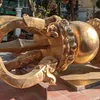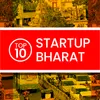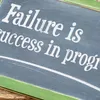Trends and opportunities: How Serendipity Arts Festival 2023 highlights creative diversity
In Part II of our photo essay from this multi-disciplinary festival in Goa, we share more artistic highlights and curator perspectives.
Launched in 2014, PhotoSparks is a weekly feature from YourStory, with photographs that celebrate the spirit of creativity and innovation. In the earlier 735 posts, we featured an art festival, cartoon gallery. world music festival, telecom expo, millets fair, climate change expo, wildlife conference, startup festival, Diwali rangoli, and jazz festival.
Spread across 12 venues in Goa, the Serendipity Arts Festival showcases a range of cultural programmes in indoor and public spaces (see Part I of our photo essay here). The combination of spaces brings art to a broader audience and opens up new ideas and connections for creativity.

One of the musical highlights was a collaboration between Nimad and the Bombay Brass band. Folk music and video backdrops showcased Nimadi folk music and village life from Madhya Pradesh, while Bombay Brass brought in elements of jazz with Western instruments.
Such showcases and blends of traditional and contemporary culture are a hallmark of the Serendipity Arts Festival, across music, dance, arts, theatre, and even cuisine.
For example, there are talks and workshops on the origins and use of ghee, vinegar and paneer in Indian cuisine, sessions on cooking tubers, author presentations (e.g. Archana Pidthala, Five Morsels of Love), and spotlights on traditional Goan cuisine and its modern variations.

Thomas Zacharias
Chef-entrepreneur Thomas Zacharias and The Locavore Team have curated these sessions with the theme Doing Good With Food, focusing on promoting local produce along with contemporary influences.
“Such activities are intended to counter erosion of cultural heritage,” Zacharias tells YourStory, pointing to low farmer wages and plastic waste as other challenges in the food business.
His Locavore platform connects local grassroots communities with market opportunities.
The appropriately-titled Food Lab showcases a range of chefs with demonstrations and delicious samples of cuisine. There are video screenings of stories about 30 seasonal vegetables, with nutritional and culinary tips.

Arts curator Veerangana Solanki features exhibits showcasing the use of digital technology.
“This is not just about apps and animation, but also the earlier era with big CRT monitors and CDs,” she explains.
Her research and exhibitions have spanned ancestral art as well as youth forms of expression.
“It is important to look at how people get ideas and why these ideas are important for them,” she adds.
Crafts curator Sandeep Sangaru travelled across India and discovered its rich heritage in fields like bamboo products.
“Bamboo is not an off-the-shelf product, it requires many stages of processing after harvest,” he explains.

“From baskets to buildings, bamboo has many uses beyond the utilitarian that are also sustainable,” he adds.
His work in connecting bamboo-making communities with urban designers and developers also led to projects in China. Sangaru will be one of the curators for the 2024 edition of SAF as well.
Music curator Ricky Kej, a three-time Grammy Award winner, has picked performances that show how music can increase awareness about climate change.
“Climate change can pose an existential threat, and poses larger challenges beyond current crises like human conflict,” he explains.
He performed at COP28, the United Nations Climate Change Conference recently held in Dubai.
“There were successes and failures. There was dialogue with world leaders, but we need to cover ground faster,” Kej observes.

In addition to children’s songs about nature, he featured artistes who use everyday objects as musical instruments.
“Connecting to nature is good for the environment–it also leads to peace,” Kej affirms.
Dance curator Mayuri Upadhya is Co-founder and Artistic Director of Nritarutya, providing artistic infrastructure for the culture community.
“When there is less funding from government, artistes need to become more enterprising, like entrepreneurs,” she explains.
“Dancers need to go beyond simplistic classifications like purists or pop artistes,” she adds.
“As a curator, I look at the artistic as well as emotional aspects of dance – it is a balancing act, like a chameleon,” Upadhya observes.

“India has a large creative ecosystem with many career opportunities. In the pre-colonial era, artisanal goods were one of India’s biggest strengths,” explains Sunil Kant Munjal, Chairman of Hero Enterprise and Founder Patron, Serendipity Arts Foundation.
“Connecting village artisans to city consumers in India and around the world and contemporising their work unlocks huge potential,” he adds.
Arts is key part of society and the economy, and education should encompass STEAM (science, technology, engineering, arts, mathematics) and not just STEM.
“Even technology should be taught with perspectives from the liberal arts,” he affirms. “As a nation, we must remember that no civilisation can be built on technology alone,” Munjal signs off.
Now what have you done today to pause in your busy schedule and harness your creative side for a better world?



















(All photographs were taken by Madanmohan Rao on location at the festival.)
See also the YourStory pocketbook ‘Proverbs and Quotes for Entrepreneurs: A World of Inspiration for Startups,’ accessible as apps for Apple and Android devices.













